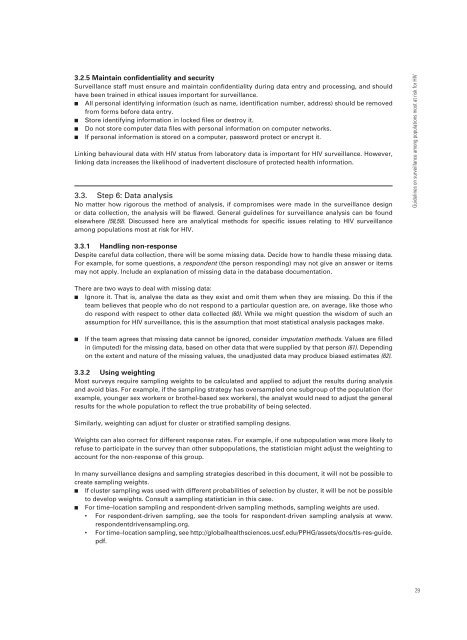Guidelines on surveillance among populations most at risk for HIV
Guidelines on surveillance among populations most at risk for HIV
Guidelines on surveillance among populations most at risk for HIV
- No tags were found...
Create successful ePaper yourself
Turn your PDF publications into a flip-book with our unique Google optimized e-Paper software.
3.2.5 Maintain c<strong>on</strong>fidentiality and securitySurveillance staff must ensure and maintain c<strong>on</strong>fidentiality during d<strong>at</strong>a entry and processing, and shouldhave been trained in ethical issues important <strong>for</strong> <strong>surveillance</strong>. All pers<strong>on</strong>al identifying in<strong>for</strong>m<strong>at</strong>i<strong>on</strong> (such as name, identific<strong>at</strong>i<strong>on</strong> number, address) should be removedfrom <strong>for</strong>ms be<strong>for</strong>e d<strong>at</strong>a entry. Store identifying in<strong>for</strong>m<strong>at</strong>i<strong>on</strong> in locked files or destroy it. Do not store computer d<strong>at</strong>a files with pers<strong>on</strong>al in<strong>for</strong>m<strong>at</strong>i<strong>on</strong> <strong>on</strong> computer networks. If pers<strong>on</strong>al in<strong>for</strong>m<strong>at</strong>i<strong>on</strong> is stored <strong>on</strong> a computer, password protect or encrypt it.Linking behavioural d<strong>at</strong>a with <strong>HIV</strong> st<strong>at</strong>us from labor<strong>at</strong>ory d<strong>at</strong>a is important <strong>for</strong> <strong>HIV</strong> <strong>surveillance</strong>. However,linking d<strong>at</strong>a increases the likelihood of inadvertent disclosure of protected health in<strong>for</strong>m<strong>at</strong>i<strong>on</strong>.3.3. Step 6: D<strong>at</strong>a analysisNo m<strong>at</strong>ter how rigorous the method of analysis, if compromises were made in the <strong>surveillance</strong> designor d<strong>at</strong>a collecti<strong>on</strong>, the analysis will be flawed. General guidelines <strong>for</strong> <strong>surveillance</strong> analysis can be foundelsewhere (58,59). Discussed here are analytical methods <strong>for</strong> specific issues rel<strong>at</strong>ing to <strong>HIV</strong> <strong>surveillance</strong>am<strong>on</strong>g popul<strong>at</strong>i<strong>on</strong>s <strong>most</strong> <strong>at</strong> <strong>risk</strong> <strong>for</strong> <strong>HIV</strong>.<str<strong>on</strong>g>Guidelines</str<strong>on</strong>g> <strong>on</strong> <strong>surveillance</strong> am<strong>on</strong>g popul<strong>at</strong>i<strong>on</strong>s <strong>most</strong> <strong>at</strong> <strong>risk</strong> <strong>for</strong> <strong>HIV</strong>3.3.1 Handling n<strong>on</strong>-resp<strong>on</strong>seDespite careful d<strong>at</strong>a collecti<strong>on</strong>, there will be some missing d<strong>at</strong>a. Decide how to handle these missing d<strong>at</strong>a.For example, <strong>for</strong> some questi<strong>on</strong>s, a resp<strong>on</strong>dent (the pers<strong>on</strong> resp<strong>on</strong>ding) may not give an answer or itemsmay not apply. Include an explan<strong>at</strong>i<strong>on</strong> of missing d<strong>at</strong>a in the d<strong>at</strong>abase document<strong>at</strong>i<strong>on</strong>.There are two ways to deal with missing d<strong>at</strong>a: Ignore it. Th<strong>at</strong> is, analyse the d<strong>at</strong>a as they exist and omit them when they are missing. Do this if theteam believes th<strong>at</strong> people who do not resp<strong>on</strong>d to a particular questi<strong>on</strong> are, <strong>on</strong> average, like those whodo resp<strong>on</strong>d with respect to other d<strong>at</strong>a collected (60). While we might questi<strong>on</strong> the wisdom of such anassumpti<strong>on</strong> <strong>for</strong> <strong>HIV</strong> <strong>surveillance</strong>, this is the assumpti<strong>on</strong> th<strong>at</strong> <strong>most</strong> st<strong>at</strong>istical analysis packages make.If the team agrees th<strong>at</strong> missing d<strong>at</strong>a cannot be ignored, c<strong>on</strong>sider imput<strong>at</strong>i<strong>on</strong> methods. Values are filledin (imputed) <strong>for</strong> the missing d<strong>at</strong>a, based <strong>on</strong> other d<strong>at</strong>a th<strong>at</strong> were supplied by th<strong>at</strong> pers<strong>on</strong> (61). Depending<strong>on</strong> the extent and n<strong>at</strong>ure of the missing values, the unadjusted d<strong>at</strong>a may produce biased estim<strong>at</strong>es (62).3.3.2 Using weightingMost surveys require sampling weights to be calcul<strong>at</strong>ed and applied to adjust the results during analysisand avoid bias. For example, if the sampling str<strong>at</strong>egy has oversampled <strong>on</strong>e subgroup of the popul<strong>at</strong>i<strong>on</strong> (<strong>for</strong>example, younger sex workers or brothel-based sex workers), the analyst would need to adjust the generalresults <strong>for</strong> the whole popul<strong>at</strong>i<strong>on</strong> to reflect the true probability of being selected.Similarly, weighting can adjust <strong>for</strong> cluster or str<strong>at</strong>ified sampling designs.Weights can also correct <strong>for</strong> different resp<strong>on</strong>se r<strong>at</strong>es. For example, if <strong>on</strong>e subpopul<strong>at</strong>i<strong>on</strong> was more likely torefuse to particip<strong>at</strong>e in the survey than other subpopul<strong>at</strong>i<strong>on</strong>s, the st<strong>at</strong>istician might adjust the weighting toaccount <strong>for</strong> the n<strong>on</strong>-resp<strong>on</strong>se of this group.In many <strong>surveillance</strong> designs and sampling str<strong>at</strong>egies described in this document, it will not be possible tocre<strong>at</strong>e sampling weights. If cluster sampling was used with different probabilities of selecti<strong>on</strong> by cluster, it will be not be possibleto develop weights. C<strong>on</strong>sult a sampling st<strong>at</strong>istician in this case. For time–loc<strong>at</strong>i<strong>on</strong> sampling and resp<strong>on</strong>dent-driven sampling methods, sampling weights are used.• For resp<strong>on</strong>dent-driven sampling, see the tools <strong>for</strong> resp<strong>on</strong>dent-driven sampling analysis <strong>at</strong> www.resp<strong>on</strong>dentdrivensampling.org.• For time–loc<strong>at</strong>i<strong>on</strong> sampling, see http://globalhealthsciences.ucsf.edu/PPHG/assets/docs/tls-res-guide.pdf.29















